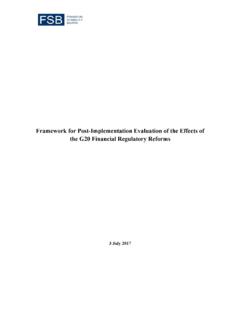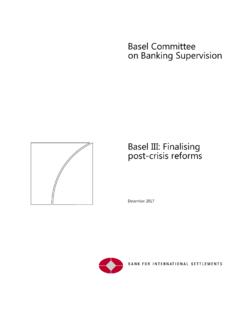Transcription of CONTRACTUAL SAVINGS IN THE LIFE INSURANCE INDUSTRY
1 CCOONNTTRRAACCTTUUAALL SSAAVVIINNGGSS IINN TTHHEE LLIIFFEE IINNSSUURRAANNCCEE IINNDDUUSSTTRRYY RREEGGUULLAATTOORRYY RREEFFOORRMMSS:: CCOOMMMMIISSSSIIOONN SSCCAALLEESS && MMIINNIIMMUUMM EEAARRLLYY TTEERRMMIINNAATTIIOONN VVAALLUUEESS February 2008 2 1. INTRODUCTION This document builds on the foundation of the March 2006 National Treasury discussion document, CONTRACTUAL SAVINGS in the Life INSURANCE INDUSTRY ( the Discussion Paper ), which outlined a range of proposals designed (i) to give effect to the December 2005 Statement of Intent ( SOI ) signed between the Minister of Finance and the life INSURANCE INDUSTRY , and (ii) to introduce further regulatory reforms with respect to CONTRACTUAL SAVINGS products.
2 The SOI committed the life INSURANCE INDUSTRY , the National Treasury and the Financial Services Board ( FSB ) collectively to finding solutions to the challenges of improving cost effectiveness and consumer protection provided by the CONTRACTUAL SAVINGS products of the life INSURANCE INDUSTRY . The first phase of the SOI commitments encompasses retrospective measures to improve policyholder value for policies written in the past and existing policies. This was given effect through regulations implemented on 1 December 2006, which provided that insurers would enhance poor policy values resulting from the early termination of retirement annuity and endowment policies that occurred after 1 January 2001.
3 The regulatory reforms outlined in this document form the next phase designed to further improve the cost effectiveness and consumer protection provided by CONTRACTUAL SAVINGS products written in the future. These reforms deal specifically with changes to the structure of commission payable on CONTRACTUAL SAVINGS products, as well as enhanced minimum early termination values. Taking due cognisance of the possible change in system requirements, a date of implementation of 1 August 2008 is proposed.
4 The reforms proposed here also provide a platform for the more far-reaching changes envisaged in the medium-term social security and retirement reform programme, as outlined in the February 2007 National Treasury discussion document, Social Security and Retirement reform . These proposed medium-term changes include improved portability of individual retirement SAVINGS , as well as governance and product standards aimed at enhancing competition among retirement SAVINGS product providers.
5 2. PROCESS Soon after the release of the Discussion Paper, a timetable for responses was released, dividing the project into three phases, or work streams. The most immediate issues to resolve were those directly impacting on the fair value being offered to investors in CONTRACTUAL SAVINGS products, namely commission scales and early termination values. These were referred to as Work Stream 1 issues. Comments on Work Stream 1 issues were required by 31 May 2006. Since then, there has been an extensive process of stakeholder consultation and regulatory drafting.
6 The regulatory reforms outlined in this document are the outcome of this process. The SOI also included a commitment by the life INSURANCE INDUSTRY to improved transparency and cost containment going forward. Many of these issues are also urgent, but require further research, and as such form a second layer of reform . Work Stream 2 issues include improved disclosure, clarity in terms of intermediary relationships, enhanced consumer education, product simplification, and broader commission issues, such as consistency across financial services industries and the 3 question of commission for risk business.
7 While there has been notable progress in many of these areas since the release of the Discussion Paper in 2006 such as the recently revised LOA Code on Benefit Expectation Management and LOA Code on Linked Annuities, as well as the development of simpler and more flexible CONTRACTUAL SAVINGS products by certain long-term insurers further research and analysis by the National Treasury and FSB on these issues is envisaged during the course of 2008. Work Stream 3 issues are those that were raised in the Discussion Paper but are to be covered under separate work programmes.
8 These concern the governance of retirement annuities, which falls under the retirement reform programme, and a proposed broader assessment of competition issues, which may be considered at a future date. The remainder of this document outlines the regulatory reforms that are the outcome of Work Stream 1. 3. CONTEXT The reforms outlined in this document must be placed in the context of the longer-term objectives for retirement and other long-term saving. Two long-term objectives are relevant, as highlighted in the National Treasury Discussion Papers dealing with retirement reform published in December 2004 and February 2007: retirement saving vehicles should provide full portability of benefits; and there is a general policy preference for this sector to be driven by market forces rather than regulatory intervention, provided the market is characterised by effective competition.
9 There are a number of implications of these principles. Disclosure will need to be significantly improved, as will consumer understanding of financial needs and the products available to meet them. This will help consumers choose products on the basis of need and enable them to select providers on more objective measures of value to the customer. The intention is that the conditions for de-capping commission will be more favourable by the time the retirement reform is fully implemented, allowing providers to determine, in a competitive market environment, an appropriate level and incidence of incentives for agents and intermediaries, within the constraints established by the retirement reform .
10 Commission payments need to be better aligned to customer interests. Portability can only be supported by a shift to a more as-and-when commission model or through the provider and intermediary accepting the risk of early termination. These principles will require a transition period. Current standards of disclosure do not sufficiently support consumer understanding of products, nor do they permit customers to formulate decisions on the basis of price. Legislation governing advice is in place in the form of the Financial Advisory and Intermediary Services (FAIS) Act, but needs time to take full effect.


















